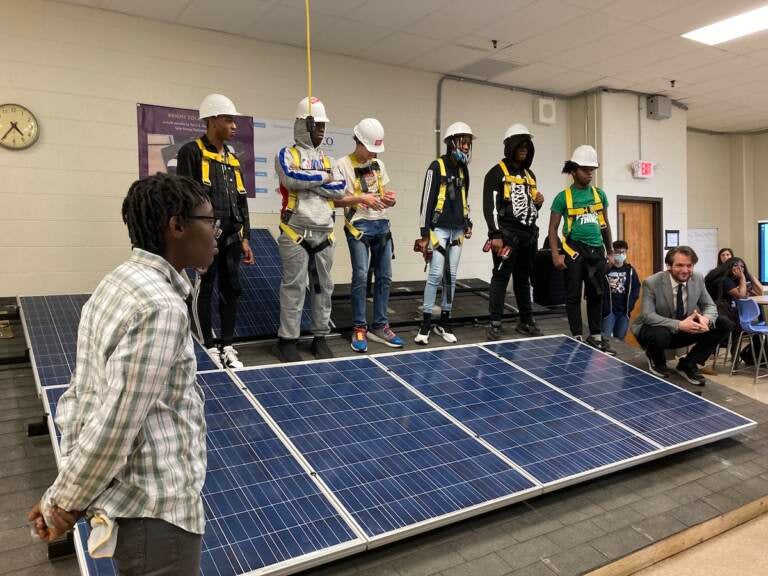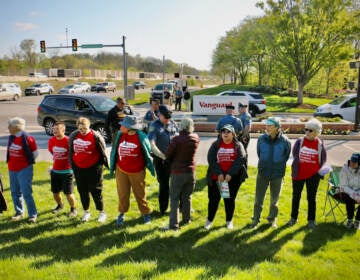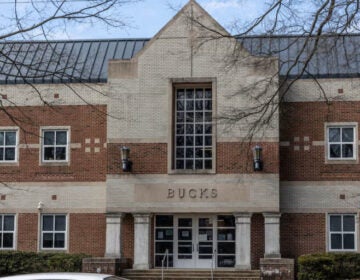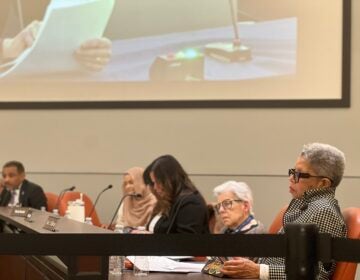Philly teens learned to install solar panels. Then asbestos closed their school
The celebrated Bright Solar Futures program went on, but without its key hands-on element.
Listen 3:35
Anthony Cruz (back row, second student with hard hat from right) and other students demonstrate installing solar modules on a model roof when U.S. Secretary of Energy Jennifer Granholm visited Frankford High School in March. (Jordan Crolly)
This story is part of the WHYY News Climate Desk, bringing you news and solutions for our changing region.
From the Poconos to the Jersey Shore to the mouth of the Delaware Bay, what do you want to know about climate change? What would you like us to cover? Get in touch.
Sixteen-year-old Frankford High School student Anthony Cruz dreams of building a company that puts solar panels on roofs.
“It’ll mostly [revolve] around installations, but I will also have a few designers and engineers there who can teach others to do the same thing,” he said. “So it’d just be all-around, not just one thing — get more business and more attention from all around the world.”
Anthony plays football at Frankford and works on the weekends. His favorite class is a federally funded program called Bright Solar Futures — a solar industry career and technical education program where he’s already learned how to install solar panels on a model roof.
“The solar program has been a fun experience,” Anthony said. “We got to learn how to properly carry the modules to the roof, how to properly put on the protective gear we use on the roof, how to use the tools properly, how to attach the modules to the roof properly.”
But for the last roughly two months of the school year, Anthony and his 10th grade classmates were not able to touch the solar modules, protective gear, or model roof. Frankford High School shuttered in April, one of six school buildings in the district to close at least temporarily this year after the discovery of damaged asbestos.
“My favorite part about it is the hands-on part,” Anthony said. “That’s why moving to virtual has been hard.”
It’s the latest example of how the School District of Philadelphia’s facilities crisis hurts student learning.
“Without actually being able to pick up the tools and do the task, I feel like there’s a whole part of it that’s just missing,” said Jordan Crolly, solar energy technology teacher at Frankford High School. “It’s been tough.”
The cutting-edge, hands-on program that trains teens to take part in the clean energy transition caught the attention of U.S. secretary of energy Jennifer Granholm, when to great fanfare she visited in March to promote the Biden Administration’s plans to accelerate the shift to clean energy and get fossil fuels out of electricity generation by 2035.
The Frankford High School building will likely remain closed next year too, but the district is looking for an alternate space nearby that students can return to in person in the fall. The district has reportedly considered demolishing and rebuilding Frankford entirely.
The Bright Solar Futures program started at Frankford High School in the fall of 2020, when Philly schools were operating online due to the pandemic. The program has been in-person the majority of the school years since then. Its first cohort of seniors graduated Tuesday.
Students in the program explore careers including solar installer, engineer, designer, electrician, or salesperson and make connections in the industry, Crolly said.
In addition to installing and uninstalling solar modules on the model roof, students learn to calculate the angle of the sun, make electrical connections, manage materials in a warehouse setting, use personal protective equipment, and stay safe on the job. They can even get a basic OSHA safety certification.
It’s easier to teach these safety concepts in person, Crolly said.
“They talk about ladder safety,” he said. “Okay, well, here’s a ladder, here’s what they’re really talking about. Get on the ladder and experience this for yourself so you see what they mean, why this is dangerous.”
When the program went virtual, Crolly said student engagement plummeted. The school closure didn’t derail student certifications, but it meant seniors couldn’t finish the hands-on elements of their final projects.
“Getting those extra [practice sessions] and being able to show that, hey, you can actually do this on your own with minimal coaching, minimal guidance,” Crolly said. “They haven’t really been able to do that yet, unfortunately. And that’s, I think, a big piece for developing that confidence around these things.”
When the building closed, the biggest hit was to social and emotional learning, Crolly said. The solar program emphasizes the importance of working as a team.
Student Anthony Cruz agrees.
“All of it is not revolved around one person doing everything,” Anthony said. “Everybody has a job. So one uses a hammer … carries the modules, passes the module down to the roof.”
But when the class is virtual, this element of teamwork is lost.
“It gets annoying sometimes,” Anthony said. “It’s harder to communicate with my classmates and my teachers.”
Being virtual also makes it difficult to focus and stay motivated, Anthony said.
“I could easily click another tab, play a game or watch YouTube or a movie and not pay attention to class and miss a whole lesson,” Anthony said.
The district is looking for an in-person space that meets the requirements of the school’s Career and Technical Education programs, said spokesperson Monique Braxton in an email. These include the Bright Solar Futures program, hospitality, aviation, and culinary arts.
The school board recently approved a five-year plan by the district to improve student achievement, which includes establishing a special facilities master plan project team to identify the investments needed to create environmentally safe and clean schools.
The Philadelphia Energy Authority, which partners with the school district to run the Bright Solar Futures program, had customized the solar classroom at Frankford High School with air conditioning, a large window, a small warehouse space to store equipment, pull-down electrical sockets throughout the room, and the electrical infrastructure needed to demonstrate interconnection of a solar array to the grid, said Emily Schapira, the agency’s president and CEO. But on a temporary basis, the program does not require a highly specialized space. Educators could expose students to different training labs through field trips, Schapira said.
“We can make do with whatever space we have. So we can always shrink down the size of things and build a new roof if we need to,” Schapira said. “If we have to, we’ll go and fundraise more and adapt as we need to because we want to make sure the kids don’t fall behind.”
If the Frankford building were to remain closed for an unexpectedly long time, the Philadelphia Energy Authority might consider moving the program to a different high school, Schapira said. But for the time being, the agency plans to continue the program at Frankford.
“We’re definitely not going to abandon these students,” Schapira said. “We’re in it for the long haul here.”

Get daily updates from WHYY News!
WHYY is your source for fact-based, in-depth journalism and information. As a nonprofit organization, we rely on financial support from readers like you. Please give today.








